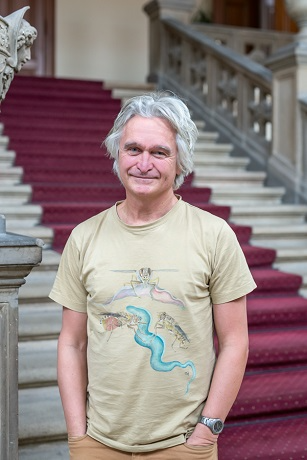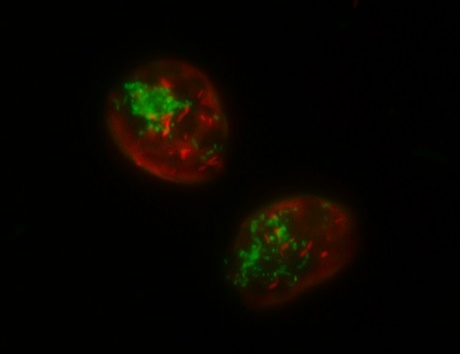Researchers uncover a genetic oddity – algae with seven different genomes
A type of single-celled algae that has been stored in a university collection in Göttingen, Germany, for more than 50 years has turned out to be an evolutionary oddity. Long-term collaborating researchers from the University of British Columbia in Vancouver, Canada, the University of Ostrava, and the Biology Centre of the CAS found that it carries seven distinct pieces of genetic information. This is a record number of genomes ever recorded in a single cell. The study was recently published in the Current Biology journal.
It is not unusual for cells to have multiple genomes. Complex cells are thought to have originated approximately three billion years ago and, in the course of their evolutionary development, integrated bacteria with which they lived in symbiosis and from which cell organelles later evolved. Almost every animal cell thus contains two genomes – the larger one is stored in the cell nucleus, while the smaller one is stored in the mitochondria, which were created during evolution by fusing with bacteria. Each plant cell also has a chloroplast genome, which was originally cyanobacteria, thanks to which plant cells gained the ability to photosynthesise.
 Czech researchers, including Julius Lukeš from the Biology Centre of the CAS, also contributed to the discovery.
Czech researchers, including Julius Lukeš from the Biology Centre of the CAS, also contributed to the discovery.
Predatory cells gobbling up red algae
An even more complex combination of four genomes is retained by cryptomonads (Cryptophyta), a group of algae. However, cryptomonads are not plant cells. They began as free-floating predatory cells and acquired the ability to photosynthesise by absorbing other cells – red algae (Rhodophyta).
And it is among the cryptomonads that we can find the Cryptomonas gyropyrenoidosa algae, which was collected sometime before 1970 by the famous botanist Ernst Georg Pringsheim and has since been preserved at his last workplace – the University of Göttingen. It cannot be ruled out that this algae could have been isolated much earlier, perhaps already during the researcher’s stay at Charles–Ferdinand University in Prague between 1923 and 1938; Ernst Georg Pringsheim was also a Czechoslovak citizen.
 Detection of the two species of symbiotic bacteria in a cryptomonad using fluorescent labelling.
Detection of the two species of symbiotic bacteria in a cryptomonad using fluorescent labelling.
Old samples, new discoveries
A Czech–Canadian team led by Emma George from the University of British Columbia in Canada requested samples of this algae so that they could analyse the complete set of DNA inside the cells and identify its origin. In addition to the four genomes within the cell, which all cryptomonads contain, the researchers discovered three more new genomes in the Göttingen algae. In fact, the Cryptomonas gyropyrenoidosa algae acquired not just one, but two additional bacterial endosymbionts, one of which is also infected with a bacteriophage virus (i.e., a virus that attacks bacteria). According to genetic analysis, these are the Grellia numerosa and Megaira polyxenophila bacteria and the MAnkyphage virus.
This conglomerate of bacteria and virus was already contained in the algae Pringsheim collected and has since been transmitted over more than 50 years of continuous cultivation in the university’s collection to all its descendants, approximating 4,400 generations. Researchers are not certain how the delicate balance between the two bacteria, the bacteriophage virus and the host cell, has been maintained.
Selfish genetic elements
Researchers have been able to show that the phage can only attack the Megaira bacteria in this close-knit community, and yet this bacteria is more numerous than its resistant counterpart, Grellia. Likewise, the relationship between the cryptomonad and the two bacteria must be kept in balance so that the algae does not get rid of the bacteria or conversely that the bacteria does not multiply to pathological levels. All this is further complicated by enigmatic selfish genetic elements.
“It is evident that the stability of this complex coexistence, spanning thousands of generations, reflects its very balanced arrangement. With considerable imagination, it is possible to see in both of the endosymbiotic bacteria the precursors of future organelles – we’re talking a time frame of at least several hundred million years,” says Julius Lukeš from the Institute of Parasitology of the Biology Centre of the CAS, whose team was involved in the discovery.
Publication: Emma E. George, et al., A single cryptomonad cell harbors a complex community of organelles, bacteria, a phage, and selfish elements, Nature Ecology & Evolution (2023). DOI: 10.1016/j.cub.2023.04.010.
Original Story Source: Columbia University, New York

 Alerts Sign-up
Alerts Sign-up